Companies large and small are betting big on an expected economic resurgence in a Florida region known more for its muck than its money.
If these firms have their way, the six-county region between Lake Okeechobee and the West Coast of Florida will become one of the fastest-growing economies in the Sunshine State in the coming decade.
Investors as diverse as Coca-Cola and CPR Tools are part of this wave of firm belief in Florida’s Heartland, an agricultural mecca that stretches from the Peace River in Central Florida all the way south to the northern outskirts of the Florida Everglades.
You won’t find a metropolitan area the scale of Tampa, Miami or Orlando in this region, but you will find the spine of Florida’s hardest-working population in places like Avon Park, Sebring, Lake Placid, La Belle, Clewiston, Wauchula, Arcadia, Moore Haven and Immokalee.
Whether toughened in the phosphate mines of Hardee and Highlands counties or weathered in the muck-covered sugarcane fields of South Florida, the workers of Florida’s Heartland typically bring three assets to the job: heart, muscle and an unwavering spirit of dedication.
There’s no air-conditioning in the mines of Fort Green or the orange groves of Zolfo Springs. But what you will find in abundant supply these days is optimism.
Atlanta-based Coca-Cola made sure of that when it announced recently that it would invest $2 billion to plant 25,000 acres of new orange groves in Polk, DeSoto and Hendry counties – the largest single investment into new crop plantings in Florida history.
“ The fact that a global beverage player is willing to make this kind of investment in the region speaks volumes. “
— Adam Putnam, Florida Agriculture Commissioner
“It’s an investment in a market that’s very important to us,” Steve Cahillane, president of Coca-Cola Americas, said at the May 7 announcement at the company’s juice-processing plant in Auburndale.
About 5 million orange trees will be planted in the new groves, marking the largest addition to the state’s citrus industry since 1998. According to Coca-Cola officials, the new plantings and resulting orange juice production should create about 4,100 new jobs in the regional economy.
At a time when total citrus acreage in the Sunshine State is declining – from 600,000 acres in 1997 to 450,000 acres today – the grove expansion project is expected to add more than $10.5 billion to Florida’s economy over the next 25 years.
‘A Real Seal of Approval’
Given that about 90 percent of Florida’s oranges are used for juice, the Coca-Cola investment should be a huge boon for the juice-processing industry throughout Florida’s Heartland. Only the nation of Brazil produces more orange juice per year than Florida.

Sarasota-based VisApp LLC is expanding by opening a new office in Arcadia in DeSoto County, Fla.
“The fact that a global beverage player is willing to make this kind of investment in the region speaks volumes,” says Adam Putnam, a former U.S. congressman who now serves in the Florida Cabinet as commissioner of agriculture. “The other half of that announcement was that two growers would split 25,000 net new acres going into production in the Heartland, and that is truly historic.”
Brazilian juice-maker Cutrale and Bill Becker’s Peace River Citrus of Vero Beach, Fla., are sharing in this mother lode of citrus investment. Much of the new crop grown in Becker’s groves will end up in the processing operations of Peace River Citrus in the Heartland.
“It’s a big help to the entire industry and to the state, for that matter,” Becker said at the time of the announcement.
Putnam calls the Coca-Cola investment “a real seal of approval for the Heartland. Coke could invest anywhere in the world, and they chose to do it right here. With the building of new intermodal rail facilities and an upgraded inland airport, all the ingredients are in place for the value-added processing and global distribution of products grown and harvested right here in South Central Florida.”
The America’s Gateway Logistics Center in Moore Haven in Glades County is a joint venture of Lykes Brothers Inc. and A. Duda and Sons Inc. Planned for 6,700 acres, AGLC is being designed to become the leading logistics solution for growers, packers and processors throughout the Heartland region.
Airglades Airport in Hendry County, meanwhile, is being developed to become a leading international air cargo overflow airport for South Florida. An 11,000-foot runway makes it a viable alternative for cargo being squeezed out of the busy Miami International Airport about an hour to the south.
“On top of all that, Duda is having conversations about a similar logistics infrastructure project somewhere else in the Heartland region,” adds Putnam. “I see tremendous potential in creating more value-added opportunities in our food-processing and beverage plant operations in this vital region of Florida. Our legacy packing house infrastructure can be restructured for other use, and all of this new development is occurring at the optimal time. Blueberry production in Florida, for example, has increased by 300 percent in the last decade.”
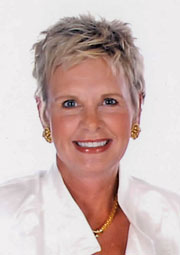
“I am looking for locations where my technology can help the area.“
— Bobbie Ayers, founder and principal, VisApp LLC
Putnam says Florida’s Heartland – comprising DeSoto, Glades, Hardee, Hendry, Highlands and Okeechobee counties – is poised to become a boom belt as worldwide demand for food and beverage products escalates.
“The food business is going to be very good for the long term,” says Putnam, who grew up in a family citrus and cattle business in Bartow on the Heartland’s northern border. “We have seven billion people in the world and we will be at nine billion by 2050. We have exploding middle classes with demands for higher quality diets and more protein. It will stress our agriculture production globally. In Florida, we are blessed to have an abundance of resources. We have nearly a year-round growing season. We have access to adequate water, sea transportation and land infrastructure. When you talk about the Heartland of Florida, you are talking about a region that has an abundance of highly productive land available for more intensive food production.”
Bumper Crop of Entrepreneurs
Some have postulated that when God created the Garden of Eden, he must have placed it in Florida’s Heartland. The area around the Kissimmee Valley and Lake Okeechobee have some of the richest soils with the best access to water that can be found anywhere on the planet.
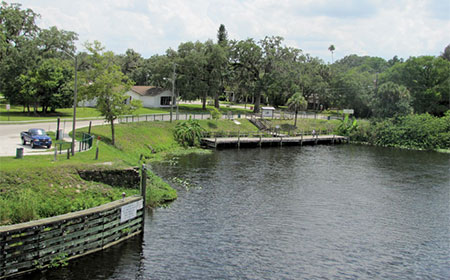
The town of LaBelle in Hendry County, Fla., is a sleepy community no more. Thanks to the rise of high-tech firms like CPR Tools, talented technical workers can now find a permanent home here.
The black topsoil is so moist and thick, in fact, that it also serves as some of the best training ground in the world for top athletes. A slew of college and professional football stars – including Florida Gator football legends Fred Taylor and Reidel Anthony – literally honed their skills by running in this muck.
“The rich muck soils south of Lake Okeechobee are some of the most fertile in the world,” notes Putnam. “It is an extraordinary strategic resource that needs to be protected.”
At the same time, this crop-friendly Heartland is providing some of the best opportunities in Florida right now for enterprising entrepreneurs. Where some folks see only farmland, others see bright young workers seeking a better future.
A case in point is John Benkert, CEO of CPR Tools in LaBelle in Hendry County. His 28-person company provides the data security and data recovery services for all 1,000 stores of OfficeMax nationwide.
“We are renting new space to add another 5,000 square feet to our headquarters here, and we will eventually build a facility that will house all of our employees under one roof,” says Benkert, who relocated himself and his family to LaBelle in 2003 after working for the National Security Agency in Washington, D.C., for many years.
“We are currently spread out in four buildings in LaBelle, with around 20,000 square feet of space,” he says. “We will increase our work force to 40 to 50 upon completion of our new space in the next year. We performed only government work until about five years ago, when we started building products for companies in data recovery. That did really well. About 18 months ago, we started marketing our software and hardware to large retailers.”

At CPR Tools, high-tech workers recover data from damaged drives, discs and other hardware in a clean-room environment.
The business really began to take off when CPR struck a deal with OfficeMax to become the national retail chain’s primary provider of data security and data recovery services. “We had to hire more data recovery engineers,” notes Benkert.
Hendry County offers CPR everything it needs to thrive, Benkert says. “We can be choosy about our location, and the truth is that this is where I want to raise my family,” he says. “I grew up in the small town of Piqua near Dayton, Ohio, so I like small towns.”
CPR was based originally in Palm Beach. “The previous owners were looking to get out of that crowded area,” the CEO adds. “The firm had been located in Palm Beach since 1987. The founding partners split up in 1995 and the company was renamed CPR Tools. It moved in 2002 from Palm Beach to LaBelle. It was really all about cost of living and finding a great place to raise a family.”
Linking Back to Education
The necessary infrastructure is in place in LaBelle to support CPR, notes Benkert. “Comcast and CenturyLink are here. Most of the people we hire are technicians,” he says. “They are hardware engineers and software engineers. They all go through our own proprietary training for hardware recovery. We put them through six months of training. They learn in the lab and do actual work on products as they come in.”
“Our central location in Florida makes this a good place for distribution centers. We are right in the middle of the population center of Florida.“
— Mandy Hines, county coordinator for DeSoto County, Fla.
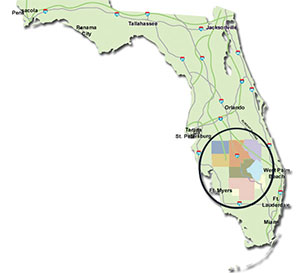
He adds that “about a third of our work force are people who graduated from local high schools, moved away to get their college education and then came back to this area to work. We are now encouraging more young people to do that by establishing internship programs at the local high schools and at schools in Fort Myers.”
The ultimate goal is for CPR to build its own facility within the next two to three years, explains Benkert. “We just completed the OfficeMax rollout for all of their stores in the U.S. in May,” he says. “We hope to build our own plant, and we feel we can thrive from our location in LaBelle. We are just five miles from the Lee County border and only 20 minutes from downtown Fort Myers. Estero, which will soon become the new corporate headquarters for the Hertz Corp., is only a 40-minute drive from here.”
Benkert also credits Gregg Gillman, president of the Hendry County Economic Development Council, with assisting CPR with some critical incentives that are enabling the company to grow in LaBelle.
Benkert is not alone in betting on the high-tech talent of Florida’s Heartland. Bobbie Ayers, CEO of VisApp LLC in Sarasota, is expanding her software design company into Arcadia in DeSoto County.
“Our software allows homebuilders to show prospective homebuyers a house with virtually any kind of interior they want,” says Ayers, whose firm plans to grow from four people to 14 employees by the end of next year.
“These are jobs in software design,” she says. “Four years ago, we moved this technology to the cloud. We are developing the mobile app and the iPad app right now so that a homeowner can go online, select a builder and then interact with various builder models. You can literally change out the paint colors, floorings and other interior features virtually on a home before you decide to buy it.”
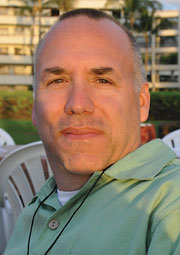
John Benkert is the CEO of CPR Tools in LaBelle in Hendry County, Fla.
Ayers says she chose Arcadia for a reason. “I am looking for locations where my technology can help the area,” she says. “We want to train people in the area for these jobs. We have discussed having local colleges help in structuring the course for this, particularly the masking skills.”
Ayers adds that she sees “a lot of potential in the people of this region. Many of the students who graduate from local schools are leaving DeSoto County to find jobs elsewhere in the technology sector. We want to train them in our technology so that they can find employment right here at home. We want to take them from a beginning level and turn them into experts.”
She says she also likes the idea of becoming an employer of choice in a small town. “I would like to have a whole city relying on our success,” she says.
DeSoto’s Day in the Sun
Mandy Hines, county coordinator for DeSoto County, says that success stories like VisApp and Coca-Cola are just the beginning for the area. The 35,000-resident county is poised to grow in several industry sectors, she says.
“The replanting of citrus groves will be a major economic impact on our county,” says Hines. “The Peace River Citrus juice-processing plants are located in this region, and we are excited about this investment.”
Hines says DeSoto should also experience solid growth in the solar energy, manufacturing and health-care sectors. “Florida Power & Light put in a 25-megawatt solar facility in our county a couple of years ago. It was the largest one in the nation at the time,” she notes. “FPL has plans to expand that facility, and I believe that we will see more solar energy projects in the future.”
Hines points to several location advantages in DeSoto: “We have great proximity to Interstate 75, U.S. Highways 17, 70 and 31, and commutable proximity to multiple international airports and seaports. We are serviced by CSX and Seminole Gulf railroads. We have a 20-square-mile enterprise zone, no building impact fees, access to an abundance of surface water supply to meet growth and industry needs, and local tax abatement authority for qualifying businesses.”
The combination of these factors makes logistics “a great opportunity here right now,” she adds. “Our central location in Florida makes this a good place for distribution centers. We are right in the middle of the population center of Florida. We have the Walmart distribution center here, and we are very close to Port Charlotte and Punta Gorda.”
A recent SRI industry cluster study analyzed DeSoto County and projected that manufacturing and small business should both experience strong growth in the area.
This Investment Profile was prepared under the auspices of Florida’s Heartland Regional Economic Development Initiative. For more information, contact Gina Reynolds at 863-385-4900 or by email at greynolds@flaheartland.com. On the Web, go to www.flaheartland.com.
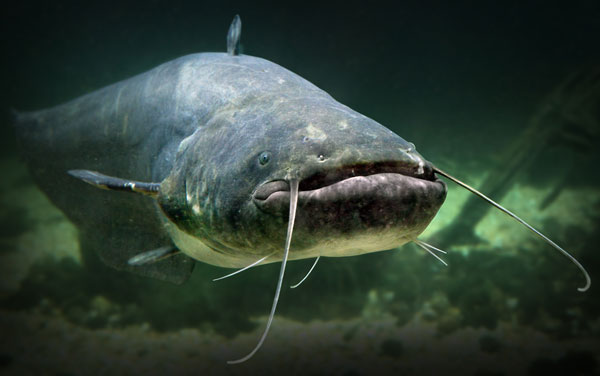 Photo: Getty Images
Photo: Getty Images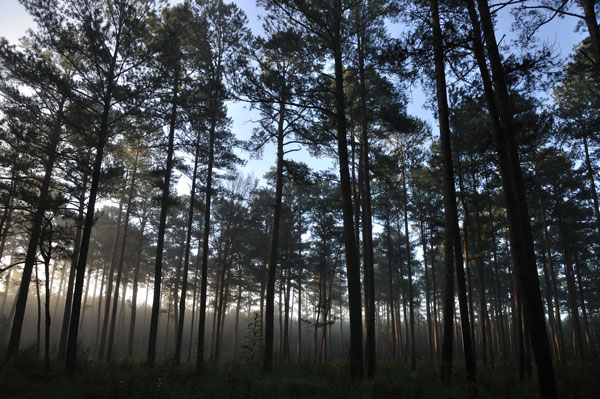 Photo: Getty Images
Photo: Getty Images







